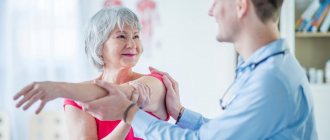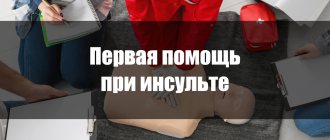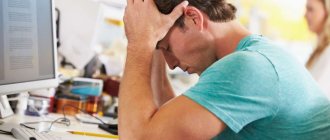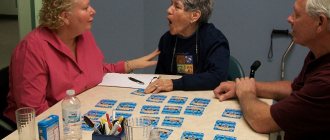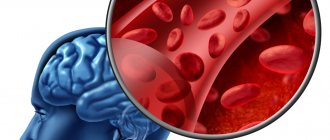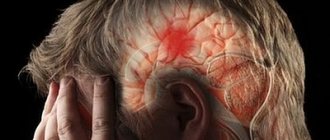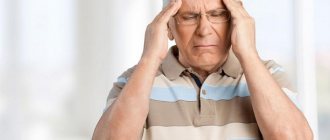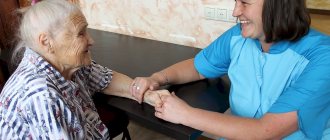The importance of physical therapy in rehabilitation
Stroke is a pathology caused by an acute circulatory disorder in the brain. There are two varieties of it, namely:
- ischemic;
- hemorrhagic.
After a stroke occurs, the patient must undergo a rehabilitation course of treatment. In addition to drug therapy, therapeutic exercises are required. It is aimed at correcting and restoring the normal functioning of the musculoskeletal system, memory, and speech apparatus.
The mechanism of therapeutic action of physical exercises
True restoration of brain function is possible only in the first 6 months. after a stroke. It is ensured by the “disinhibition” of functionally inactive nerve cells, including in the “ischemic penumbra” zone, and is due to the disappearance of edema, improvement of neuronal metabolism and synapse activity. However, it has been shown that spontaneous true recovery is ineffective without additional targeted stimulation of repair and regeneration processes using methods that make up rehabilitation treatment. Another mechanism is compensation provided by the plasticity of brain tissue with the reorganization of the functioning of neuronal ensembles.
The organization of human motor functions appears to be a multi-level system with multi-channel connections, both direct and inverse, both vertical and horizontal. The development of each motor skill is preceded by the processing of afferent impulses entering the cortex and subcortical ganglia from the periphery. For the development of a motor program, not only impulses from proprioceptors embedded in muscles, synovial membranes, ligaments, joints are important, but also from other receptors emanating from the environment (sound, light, heat, cold), as well as from receptors in the skin and mucous membranes membranes (pain, feeling of pressure, weight, moisture, etc.). These impulses inform the overlying parts of the central nervous system about the need to change the movement, its amplitude, muscle strength, the inclusion of other muscle groups, or a change in the position of the limbs. Subcortical formations, in particular the hypothalamus in combination with the limbic-reticular system, provide the vegetative “coloring” of any motor act: changes in blood supply, the speed of vascular reactions, metabolism, the appearance of pain components, burning sensations, etc. Thus, in the regulation of motor activity they are complexly intertwined motor, sensory, cognitive and other functions. All this suggests that approaches to the recovery of movement disorders can be mediated through different systems. Therefore, various methods must be used to achieve an overall systemic effect.
Restoration of motor functions occurs most actively in the first 6 months. after a stroke, ahead of the restoration of deep sensitivity and goes through the same stages as the early psychomotor development of the infant. All this determines the primary focus of early rehabilitation on the motor sphere. In the process of ontogenesis of the functional movement system, stable proprioceptive-motor connections are formed in the body, the use of which is possible only taking into account the ontogenetic patterns of development of the functional movement system. The implementation of these mechanisms in patients with cerebral stroke can become the basis for creating a rehabilitation treatment program.
The functional system of movements is highly sensitive to the influence of such negative factors as physical inactivity, which leads to a decrease or disruption of functional connections and tolerance to physical activity, or as an attempt to learn movements of a higher order, as a result of which “non-physiological”, “non-functional” connections are formed and impaired the impact of muscle tension on the joints of the limbs and torso, i.e., pathological postures and movements are formed. In this regard, when carrying out rehabilitation measures in patients with cerebral stroke, a constant, daily assessment of the state of the motor component and functional state is necessary.
The basic principles of restorative treatment of post-stroke movement disorders are early onset, adequacy, phasing, duration, complexity, continuity and maximum active participation of the patient. To successfully carry out this treatment, it is necessary to correctly assess the state of the impaired function in each patient, determine the possibility of its independent restoration, the degree, nature and duration of the defect, and on the basis of this, the choice of adequate ways to eliminate the disorder.
You should be guided by the following rules [6, p.94]:
- individual focus of impact;
- strict dosage of exposure;
- validity of the choice of forms and methods of influence;
- purposefulness, systematicity and regularity of application of the selected impact;
- gradual increase in intensity of exposure based on effective control;
- continuity in the use of selected forms and methods of physical activity at different stages of rehabilitation treatment.
Contraindications to the administration of exercise therapy to patients in the acute period of cerebral stroke are: hyperthermia; ischemic changes on the ECG; circulatory failure, significant aortic stenosis; acute systemic disease; uncontrolled ventricular or atrial arrhythmia, sinus tachycardia above 120 beats/min; third degree atrioventricular block; thromboembolic syndrome; acute thrombophlebitis; uncompensated diabetes mellitus; defects of the musculoskeletal system that make it difficult to exercise.
The use of exercise therapy in patients with cerebral stroke includes active and passive forms.
Active ones include:
- therapeutic exercises - breathing, restorative, special, reflex, analytical, corrective, psychomuscular, hydrokinesitherapy;
- occupational therapy (ergotherapy) - correction of the patient’s activity and participation in everyday habitual activities, active interaction with environmental factors;
- mechanotherapy - simple devices, block, pendulum, with electric drive, with mechanical drive;
- treatment with walking (terrentherapy) - dosed walking, health path, obstacle walking, dosed walks;
- specialized methodological systems - Clapp, Cabot, Botat, Brunstrom, balance, yoga, suspension therapy, bullet therapy, etc.;
- biofeedback - use of EMG, EEG, stabilography, spirography, dynamometry, cinematography data;
- high-tech computer technologies - virtual reality computer systems, biorobotics;
- other methodological techniques - “non-use” of the intact side, the effect of “crooked” mirrors, etc.
Passive exercise therapy includes the following forms:
- massage - therapeutic, classical, reflex, segmental, mechanical, vibration, pneumomassage, hydromassage;
- robotic mechanotherapy (terrenotherapy) extension therapy;
- manual manipulations - vertebrotherapy, joint manipulations;
- positional treatment (postural therapy) - the use of bolsters, pillows and devices;
- passive movements carried out by an instructor and a doctor;
- high-tech computer technologies - virtual reality computer systems, biorobotics.
Therapeutic gymnastics for patients with cerebral stroke includes the use of various positions, movements and exercises for therapeutic purposes, both by the patient independently and with the help of specialists and additional devices.
The benefits and effects of charging at home
The main task that therapeutic exercises cope with is the complete restoration of the body’s functioning .
In addition, it performs many secondary functions:
- If a patient experiences paralysis after a stroke, this indicates muscle tone . You can remove it with the help of special exercises;
- Restoring coordination of movements;
- Blood supply to tissues increases , as a result of which metabolic processes are activated, the condition returns to normal faster;
- Preventing bedsores. Prolonged stay in the same position disrupts blood microcirculation. Gymnastics helps prevent the formation of bedsores.
Important! Exercise therapy is the main component of rehabilitation after a stroke.
Pain in the leg and arm after a blow
Often, patients after a stroke complain that they feel a slight pain or burning sensation in a paralyzed arm or leg. The most common form of these pains is neuropathic .
In this case, the patient feels a slight burning or tingling sensation in the limb. Usually, such sensations do not cause him much discomfort.
Often such pain indicates the restoration of the supply of stimuli from the brain to the muscles . But sometimes these sensations indicate insufficient blood flow to the limbs.
If the patient begins to say that a paralyzed arm or leg hurts, then you should immediately consult a doctor.
What to do if your limbs hurt badly? Not all painkillers can help, so it is better to call an ambulance and not wait for the pain to go away on its own.
Home exercise equipment
The use of home exercise equipment after a stroke is advisable only when the patient’s well-being has improved. They help strengthen various muscle groups and relieve tension. It is also an excellent prevention of a recurrent attack.
For home use, it is useful to purchase the following exercise machines:
- Exercise bike. Exercises with an exercise bike are aimed at accelerating the recovery process. It improves the functioning of the lower extremities;
- Verticalizer. It is intended for patients whose motor system has been affected and who are unable to stand up on their own. The essence of the verticalizer is to lift a person, preparing him to be able to take a vertical position;
- Lokomat simulator. Helps those people who have lost the ability to walk. With its help, the patient learns to move again;
- Active-Passive simulators. Promote the restoration of the upper and lower extremities, hip and knee joints;
- Mini exercise equipment for limbs. They develop and train their fingers and hands. as well as the lower limbs.
Important! The use of simulators allows you to more quickly restore the normal functioning of the musculoskeletal system, as well as prevent a recurrent stroke.
Methods of physical rehabilitation at different stages of stroke
The most acute period
The objectives of rehabilitation during this period are:
- restoration of the normal pattern of active breathing;
- formation of symmetrical sensory afferentation from proprioceptors of joints and muscles during positional treatment;
- formation of a stable response of the autonomic nervous system to dosed load;
- early transfer of the patient to a vertical position (passive and active);
- restoration of the static and dynamic stereotype of the axial muscles (deep muscles of the spine, neck, back, muscles of the chest, abdomen, diaphragm);
- correction of swallowing disorders;
- control over recovery processes.
The following types of exercise therapy are used in the neuroreanimation unit:
- treatment by position;
- breathing exercises;
- ontogenetically oriented kinesitherapy (physical therapy), including elements of specialized systems: PNF, Felden-Kreis, Vojta;
- transfer to a vertical position using a robotic rotary table.
Positional treatment aims to give the paralyzed limbs a correct, bilaterally symmetrical position while the patient is in bed or sitting in a bedside chair. Despite its simplicity, when performed correctly, positional treatment is important and helps to reduce muscle spasticity, equalize asymmetry of muscle tone, restore the body diagram, increase deep sensitivity, and reduce pathological activity from tonic cervical and labyrinthine reflexes. This, in turn, prevents the development of pain and pathological attitudes in the limbs and torso, and subsequently contractures. In addition, positioning treatment can be performed on all patients, regardless of the severity of the condition, and almost from the first hours of a stroke.
Positional treatment involves placing the paralyzed limbs in the following patient positions: on the healthy side; on the paralyzed side; in the position opposite to the Wernicke-Mann position; on the stomach. Negative factors of the patient's position on the back are: insufficient respiratory function of the lungs, poor bronchial drainage, decreased pulmonary volume due to the high position of the diaphragm, high risk of saliva aspiration, increased pathological reflex activity of the cervical-tonic and labyrinthine reflexes, pain in the spine due to prolonged staying in one position. The patient should remain in each position for 20 to 40 minutes.
Breathing exercises are aimed at normalizing hemodynamics, restoring oxygenation, relieving hypoxic hypoxia, and forming a stable normal dynamic breathing pattern. Passive techniques include contact breathing (accompaniment and stimulation of respiratory movements by touching the hands to the chest), vibration using the hands as you exhale, shaking, therapeutic body positions (drainage positions, positions that facilitate breathing and aeration, promoting mobilization of the chest), intercostal stroking ( skin and muscle technique).
According to the PNF (Cabot) method, at the first stage it is necessary to obtain complex physiological movement in the axial muscles of the patient, then in the belt of the upper or lower extremities, simultaneously combining it with movements in the torso, using the techniques of short stretching, adequate resistance to movement, reversion (changing the direction of movement) antagonists, approximation (increasing the pressure of articular surfaces on each other) of joints with strict control of the physiology of the patient’s posture.
Since the greatest problem of the acute period is dysregulation of motor function, it is inappropriate to use “ordinary” active movements (separate flexion, extension, abduction, adduction in different joints), which are complex active movements of a healthy person, which are not yet available to the patient. When carrying out this type of movement, the body uses functioning intact, more primitive programs, which, if the tasks do not correspond to the results, contribute to the formation of pathological stable posnotonic attitudes, i.e., contribute to the consolidation or formation of pathological motor stereotypes.
Early transfer of patients to a vertical position involves a set of measures. During passive translation 1) a verticalizer table is used according to a special protocol in order to stimulate deep sensitivity receptors, the vestibular apparatus, and restore autonomic reactivity; 2) change the position of the head of the bed in the process of daily care for the patient, give the body an elevated position when eating, gradually lower the lower limbs and transplant the patient. Active verticalization is carried out depending on the functional state and motor capabilities of the patient.
3.2 Acute period
The objectives of rehabilitation are:
- maintaining symmetrical sensory afferentation from proprioceptors of joints and muscles during positional treatment;
- maintaining a stable response of the autonomic nervous system to a dosed load of increasing intensity;
- consistent change in the patient’s body position;
- increasing tolerance to physical activity;
- stage-by-stage restoration of the dynamic stereotype of the trunk and proximal, middle and distal parts of the upper and lower extremities - destabilization of pathological systems;
- concentration of attention on the sequence and correctness of “inclusion” of muscles in a specific motor act;
- intensification of the processes of restoration and (or) compensation of the defect with the activation of the individual reserves of the body due to the formation of new functional connections;
- the use of synkinesis at the stage of initialization of physiological motor activity;
- inhibition of non-physiological movements and pathological postural attitudes, increasing the amplitude and accuracy of active movements, combating increased muscle tone and leveling its asymmetry;
- improvement of sensory support for motor acts (visual, verbal, tactile control);
- restoration of the static stereotype of a vertical position;
- beginning of training in symmetrical walking skills with additional support, active independent walking;
- correction of swallowing disorders;
- correction of speech disorders;
- training in safe movement using additional support;
- training in the elements of functional adaptation to performing socially significant actions for self-care and restoring an active role in everyday life;
- control over recovery processes.
In a specialized neurological department, the following methods are used: positional treatment; breathing exercises (active techniques); further gradual transfer of the patient to a vertical position; ontogenetically determined kinesiotherapy; mechanotherapy; exercises on cyclic simulators; training using biofeedback based on parameters of electroneuromyography, stabilometry, goniometry; dynamic propriocorrection, training in everyday skills (ergotherapy).
The main task of active breathing exercises is to develop the skill of controlling the relationship between certain phases of the respiratory cycle. The ratio of the inhalation and exhalation phases should be 2:3, the ratio of pauses in the act of breathing -1:2. If you need to reduce the activity of the sympathoadrenal system, you should lengthen the time of the exhalation phase and the second pause in the breathing cycle, and if, on the contrary, increase it, lengthen the time of the inhalation phase and the first pause. Breathing should not cause tension. After 5-6 deep breaths, a break of 20-30 seconds is advisable.
The second task of active breathing exercises is the process of learning to slowly perform all phases of breathing with its gradual deepening. Such exercises will lead to an increase in oxygen consumption from the inhaled air while maintaining the level of carbon dioxide, which will effectively reduce blood pressure and heart rate, will help establish a slow breathing pattern and “break” the pathological hyperventilation and fast breathing pattern.
Solving the problems of breathing exercises is also facilitated by hypoxic training carried out on special breathing simulators. The operating principle of these devices is to supply air into a breathing mask with a normal oxygen content and an increased carbon dioxide content.
The dosed impact of rehabilitation measures without overstraining the cardiovascular and respiratory systems is a necessary condition for restoring an upright position and walking. In the function of moving the body, including walking as a method of movement, two points stand out. The first of them is associated with moving the body in space and maintaining balance in each of the positions it occupies, the second with the possibility of trophic support for this work. The choice of the starting position for correcting motor function is determined, first of all, by the adequate ability of the cardiovascular and respiratory systems to ensure activity in a given body position. It is very important to monitor the patient’s general condition parameters (blood pressure and heart rate) during each exercise and during the recovery phase.
Massage and passive gymnastics begin simultaneously with positional treatment, if there are no contraindications to their use.
Passive performance of movements helps maintain the elasticity of the muscular-ligamentous apparatus, trophism in the limbs and torso. Passive performance of complex spiral-shaped three-plane movements that promote rapid stretching of the muscular-ligamentous apparatus by 20 - 30% of the average physiological position helps stimulate the activity of motor units and initiate contractile activity in the paretic muscle.
Since patients with cerebral stroke experience a selective increase in muscle tone, massage in these patients should also be selective, i.e., different techniques should be used when massaging hypertonic muscles and muscles in which hypotension develops. Any additional afferentation from hypertonic muscles can cause an even greater increase in their tone, therefore, in the method of selective massage of muscles with increased tone, only continuous planar and grasping stroking is used as the most gentle technique, causing afferentation only from the skin. The technique of acupressure in combination with acupuncture is aimed at reducing muscle tone and irritating deep receptors. Acupressure and acupuncture for patients with post-stroke paralysis and paresis were developed in our country.
The ability to maintain balance in different positions and the ability to walk are restored most effectively when using a complex of ontogenetically determined kinesitherapy, simulators and devices with biofeedback, robotic mechanotherapy with unloading of the patient’s body weight.
Along with therapeutic exercises, the leading means of exercise therapy, used for more than 150 years to restore walking function, is mechanotherapy. The impact of this method must be dosed, controlled and reproducible. The quality and dosage of exercises is controlled using biofeedback parameters.
In accordance with the formula of new rehabilitation concepts “whoever wants to learn to walk again must walk,” systems with body weight support have been developed that promote symmetrical unloading of the lower extremities, which facilitates the walking of patients who are unable to move under normal conditions with full body weight, as well as unloading and correction suits. This made it possible to minimize obstacles to walking in the initial stages of rehabilitation, i.e., to begin walking training as early as possible.
One of the effective methods of restoring motor function is training based on the principle of biofeedback (BFB). These techniques are aimed at correcting muscle tone, improving sensory support for movements, increasing the amplitude and accuracy of movements, activating concentration on sensations of the degree of muscle contraction and the spatial arrangement of the limbs.
Recently, a new direction in the rehabilitation of patients has been actively developing - a method of artificial correction of walking and rhythmic movements through programmable electrical stimulation of muscles during active movement.
Restoring motor function in itself does not mean restoring the ability to perform independent self-care, which is no less important for the patient in his daily life. The priority areas of occupational therapy are restoration of daily activity (eating, dressing, washing, toileting, bathing, personal care, etc.), developing fine motor skills of the hand, selection of special disabled equipment and auxiliary equipment.
Early recovery period
The objectives of rehabilitation are:
- maintaining a stable response of the autonomic nervous system to a dosed load of increasing intensity;
- increasing the patient’s tolerance to physical activity;
- step-by-step restoration of the dynamic stereotype of the trunk and proximal, middle and distal parts of the upper and lower extremities - inhibition of non-physiological movements and pathological postural attitudes, development of the amplitude and accuracy of active movements, combating increased muscle tone and leveling its asymmetry;
- improvement of sensory support for motor acts (pro-prioceptive, visual, verbal, tactile control);
- restoration of the static stereotype of a vertical position;
- continued training in symmetrical walking skills with additional support and active independent walking;
- correction of speech disorders and disorders of higher mental functions, psycho-emotional state;
- continued training in safe movement using new means of additional support and movement;
- continuing training in the elements of functional adaptation to performing socially significant actions for self-care and restoring an active role in everyday life;
- control over recovery processes.
The continuous use of all methods that were used at the inpatient stage of rehabilitation continues, depending on the initial condition of the patients and the results achieved. The early recovery period of rehabilitation is aimed at further expanding the patient’s functional and motor capabilities with a reasonable choice of the listed methods, as well as combating complications of the acute period: contractures, high tone, pathological alignment of the trunk, limbs, fingers, deep vein thrombosis of the lower extremities, urinary disorders functions and bowel movements, which mostly occur when the basic principles of patient management are violated.
For independent exercises, it is widely recommended to perform only those movements that the patient can actively perform himself biomechanically correctly to an accessible extent under the supervision of relatives or caregivers. Recommendations to “develop” movements performed with a pronounced deviation from the norm on your own in this category of patients will lead to the consolidation and formation of new pathological stereotypes, an increase in tone and pain reactions.
In order to increase the patient's tolerance to physical activity, it is advisable to use cyclic simulators that allow you to perform movements of the upper or lower extremities in an aerobic mode in passive, passive-active, active modes. The intensity of the workout should not exceed 25% of maximum oxygen consumption. Intensity control is carried out based on heart rate, oxygen saturation and blood pressure.
The choice of the number of rehabilitation methods used and their sequence depends both on the individual level of the patient’s functional capabilities and on the goals of the training. It should be remembered that the transition to the next level of load is possible only after complete recovery from the previous one, in the supercompensation phase.
The active participation of the patient in rehabilitation activities, as experience shows, plays a significant role in the restoration of impaired functions and, especially, complex motor skills and social readaptation. In this regard, in the early recovery period, special attention is paid to the correct choice of means to facilitate the patient’s biomechanically correct performance of a particular function (unloading frames for walking, crutches, walkers, canes, suits, robotic exoskeleton elements, medications, orthoses) and provide psycho-emotional support and pedagogical supervision.
Late recovery period and period of persistent residual manifestations
During these periods, the importance of solving problems of actively moving patients with the help of additional support and special means (strollers), improving walking and self-care skills increases. The role of ergotherapeutic and psychotherapeutic methods for correcting the condition is increasing.
A feature of the late period of rehabilitation is the persistence of the neurological deficit. The patient has varying degrees of manifestations of both central and peripheral paresis due to “non-use” of body segments and functions due to the initial lesion. No less significant are the manifestations of somatic pathology against which the stroke developed or which manifested itself during the recovery period.
The objectives of rehabilitation measures in the late period are:
- normalization of tone-strength relationships between the muscles of the regions of the patient’s body and the proper range of movements in individual joints of the torso and limbs;
- further continuation of the improvement of motor functions with an emphasis on the process of maintaining a vertical position and movement (independently, with additional support, with the help of technical means or another person), improvement of coordination in space, fine targeted motor skills of the hand and fingers (improvement of gripping, manipulation), coordination of work muscles of the orofacial complex, respiratory muscles;
- further increase in the patient’s tolerance to stress, both physical and psycho-emotional;
- restoration and maintenance of trophism of tissues of the musculoskeletal system;
- overcoming pain syndrome;
- restoration and maintenance of the patient’s excretory and sexual functions;
- restoration of speech and higher mental functions;
- improving the patient’s adaptation to the environment through the use of ergotherapeutic technologies and occupational therapy, as well as adapting the environment to the needs of a patient with severe functional limitations;
- professional reorientation based on occupational therapy activities;
- restoration of interpersonal relationships, social activity of the patient, his role function in a significant environment.
As in previous periods of rehabilitation, the patient’s daily regimen is very important for the formation of stable and economical proper reactions to interventions (activities), taking into account the location of the patient and the places where therapeutic activities are carried out, the possibilities of moving to the place of exercise, eating habits, hygiene and social activity (work , participation in public life, family responsibilities, etc.). Maximum independence of the patient should be ensured. In order to restore motor functions, morning hygienic exercises, exercise therapy and physiotherapeutic measures are used.
Morning hygienic exercises should include only those exercises that the patient can perform independently to an accessible extent. They are cyclic in nature, symmetrical and reproduced at least 7 times, including exercises of the orofacial complex. Exercises are performed in a well-ventilated room, preferably in front of a large mirror (self-monitoring), with mandatory measurement of blood pressure and heart rate. The duration of gymnastics is no more than 10-15 minutes. Self-performed exercises (with the correct recommendations of a specialist) and the ability to self-control will help increase the patient’s motivation for rehabilitation activities and save time on special kinesiotherapy classes. Exercise therapy classes in the late period should be carried out at least 3 times a week.
A current direction of rehabilitation measures in the late recovery period is massage. As in the earlier stages, reflex, segmental, acupressure massage is used, used in combination with therapeutic exercises, mechanotherapy, drug therapy, and physiotherapy. It prepares tissues for work, reduces the effect of intense work and promotes a more complete and rapid recovery.
The initial stage of restorative gymnastics in a supine position
Therapeutic gymnastics in a supine position is carried out at an early stage of recovery, when the patient cannot yet rise independently. Let's look at the most effective exercises in this case.
Gymnastics for arms
It’s actually difficult to call such a manipulation an exercise, but the load on the patient is enormous. Its essence lies in the extension of the upper limbs , starting from the phalanges of the fingers to the forearm. Then the hand is completely wrapped around a board with a straight surface. You need to remain in this position for about half an hour.
Video about gymnastics for arms:
Eye muscles
You need to move your eyes, looking up and down and left and right. Then close your eyes and make circular movements with them in different directions, repeat the same thing, only with your eyes open. As a form of rest between manipulations, it is useful to blink quickly for several seconds.
Phalanges of fingers
In any position that is comfortable for the patient, it is necessary to bend and straighten the fingers at least 10 times. You can do this on both limbs at the same time. If it's hard, then take turns.
For arms and legs
If one limb is paralyzed, hang a towel over the bed in a loop shape. Place your hand through it and swing it, increasing the amplitude. Like this. The same manipulation can be carried out with motionless lower limbs.
We invite you to watch a video about leg gymnastics:
Elbow joints
Stretch along the bed, upper limbs should lie parallel to the body. Bend your left arm, then lower it onto the bed. Do the same with your right hand. Perform the exercise alternately, 10 times for each limb.
Knee joints
While lying on your back, bend your right and left knees alternately. In this case, you should try not to lift your foot off the bed. Perform manipulations 10 times on each leg.
Pull-up
In the supine position, you need to grab the headboard of the bed. Try to pull up your whole body with your arms. Your shoulders should be straightened and your legs straight. The exercise should be done slowly, at least 6 approaches.
Important! During gymnastics, either a loved one or a nurse must be present with the patient in a lying position!
Exercises in a sitting position
If the patient already has the physical ability to sit independently, you can proceed to the next stage - gymnastics in a sitting position. It is aimed at improving the functioning of the limbs, strengthening the back muscles and preparing for walking. Let's look at recovery exercises:
- Sit on the bed, lower your feet to the floor. Hold onto the bed with your hands. Bend your back, pushing your chest forward. In this case, the deflection should be while inhaling, you need to relax while exhaling;
- In a sitting position, place your legs on the bed. Lift each limb up in turn. The legs should be straight;
- Lean your back on the pillow, stretch your legs forward, arms up. Bend your leg at the knee, clasp it with your hands. In this case, you must try to touch the knee joint with your chest. Hold for a couple of seconds, tilt your head forward, and exhale. Then raise your head and slowly return to the starting position. Do the same manipulation with the second leg;
- Lean back on the pillow, taking a comfortable position. Grasp the edges of the bed with your hands. Throw your head back, trying to bring your shoulder blades together. Remain in this position for a few seconds, return to the starting position;
- Sit on the bed with your legs dangling. Turn your head in different directions, then make circular movements. Manipulations should be slow;
- It is also useful to simply sit on the bed with your legs down. But the main condition is to not hold on. This exercise helps restore coordination and prepare for walking.
Important! At this stage, fine motor skills should be developed by sorting small objects.
We invite you to watch a video on how to exercise in a sitting position:
Recovery Exercises
Recovery at home after a stroke should begin while still lying down, when the person practically does not get up. Exercises should cover all joint parts of a person, but in this case exercises specifically for the lower limbs will be described in more detail:
ATTENTION! Basic actions in a supine position are indicated for patients who have suffered a complex ischemic or hemorrhagic stroke. Under such circumstances, unilateral paralysis often occurs.
For bedridden patients:
- Hands perform flexion, extension and rotation actions. Clenching your fingers into a fist. Similar movements are made with your feet; you should try to close and open your toes;
- Carry out movements with toes and heels, flexion and extension movements, as well as bending the feet in and out;
- While lying on your back, you need to bend your legs at the knees. Near the ankle joint, hands clasp the shins. Using your hands, you need to bend your legs in the area of the shin, while the foot does not come off the bed, but only slides along the surface of the bed;
- The legs perform a “bicycle” movement.
Exercises from a sitting position are aimed at strengthening the muscular base of the arms and back. They are necessary as preparatory measures before walking :
- You need to sit on the bed with your legs down, your arms down and out, grasping the bed. The back arches, the body leans forward, hands hold on to the bed. You need to take a breath, relax and exhale. And so on up to 10 times;
- When sitting on the bed, your legs are not lowered. You need to lift each leg in turn. Throw your arms behind your head and rest them on the bed. Try to lift both legs;
- Sitting, feet on the bed, hands behind your back resting on the bed. The shoulder blades should be brought together and spread apart. The head tilts back and returns to its original position. It is worth breathing correctly at the same time; when moving the shoulder blades back, you inhale, spreading them apart, and exhale.
Exercise therapy from a standing position (legs still can’t walk well, so you need to do it with support on something):
- Lifting small objects while standing, first from a low surface, then from the floor.
- Taking small steps in place, holding onto a support. Then mastering walking skills.
- Stepping your foot over the block, forward and backward.
- Such exercises will restore balance to a person.
Gymnastics in a standing position
Such gymnastics is carried out after the patient has completed the entire range of previous exercises and can confidently stand on his feet. Depending on the person’s condition, standing exercises are divided into 2 types: simple and increased load.
Simple therapeutic exercises that are suitable for patients who have not yet fully recovered from a stroke include:
- Place your arms along your body, feet shoulder-width apart. Stretch your arms up, palms should be directed outward. Stretch, take a deep breath. Slowly lower your arms while exhaling. Repeat the exercise 6 times;
- Squats are another effective method during stroke rehabilitation. You need to squat carefully, while trying not to lift your heels off the floor. Repeat the exercise 4 times;
- Place your feet shoulder-width apart and place your hands on your waist. Bend to the right side, raising your left arm in parallel, and vice versa. 4 repetitions of this exercise are enough;
- Place your hands on your belt and point one leg forward. Make circular movements with the lower limbs one at a time - 4 times for each;
Increased load involves performing the following exercises:
- Spread your legs slightly, lower your arms down. Then fold the hands into a lock and place them in front of you. Raise your clasped hands, stretching your whole body upward. Return to starting position. Repeat 5 times.
- Place your feet together. Raise one hand up, leave the other down. Swap them for each count. Do 10 times.
- Place your hands on your belt, legs slightly apart. As you inhale, bend forward slightly, and as you exhale, return to the starting position. Repeat 10 times.
- Squats with increased load are performed a little differently: one hand should be on the belt while squatting, and the other behind the head. After each manipulation, hands need to be changed. Do 10 reps.
- It is also useful for an already stronger person to jog in place during the recovery period, but not more than 6 minutes.
Important! If exercises cause severe discomfort or pain, they should be stopped immediately!
We invite you to watch a video about exercises while standing in a chair:
Therapeutic gymnastics for the face
The following exercises will help strengthen the facial muscles and normalize the functioning of the speech apparatus:
- Show your tongue, try to stretch it forward as much as possible;
- Licking your lips in a circular motion;
- Gently bite your upper and lower lips alternately;
- Curl your lips into a tube;
- Clicking your tongue.
Pronounce simple rhymes or tongue twisters. If this process causes difficulties, then you need to start with individual sounds, continuing them with words consisting of two syllables.
Important! One of the main conditions for recovery is that the patient should hear human speech as much as possible!
